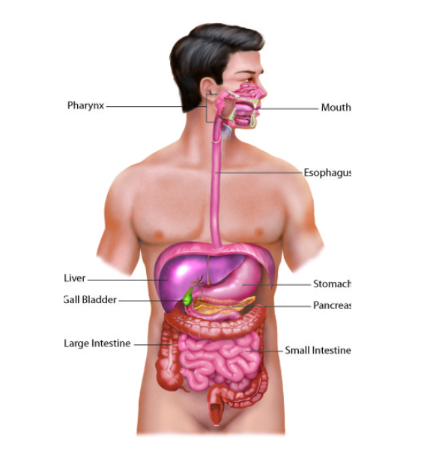Table of Contents
Introduction
The digestive system is a complex system in the human body responsible for breaking down food into nutrients that can be absorbed and used by the body for energy, growth, and repair. It consists of a series of organs and structures that work together to process and extract nutrients from the food we eat.
Digestive System Components
The digestive system is composed of several parts that work together to process food and extract nutrients. These parts include:
- Mouth: The mouth is the entry point of the digestive system. It contains teeth for chewing and breaking down food, and the tongue helps in swallowing and taste perception. Saliva is also produced in the mouth, which contains enzymes that begin the digestion of carbohydrates.
- Esophagus: The esophagus is a muscular tube that connects the mouth to the stomach. It transports food from the mouth to the stomach through a process called swallowing.
- Stomach: The stomach is a sac-like organ that receives food from the esophagus. It secretes gastric juices, including acid and enzymes, to break down food further. The stomach also mixes and churns the food, turning it into a semi-liquid substance called chyme.
- Small Intestine: The small intestine is a long tube that receives chyme from the stomach. It is the primary site of digestion and nutrient absorption. The inner lining of the small intestine is covered with finger-like projections called villi, which increase the surface area for nutrient absorption.
- Large Intestine (Colon): The large intestine is a wider tube that follows the small intestine. Its main functions are to absorb water and electrolytes from the remaining undigested food and to form and store feces.
- Rectum: The rectum is the lower part of the digestive system where feces are stored until they are eliminated from the body.
- Anus: The anus is the opening at the end of the digestive system through which feces are expelled during a bowel movement.
In addition to these primary organs, the digestive system also includes accessory organs that play a role in digestion. These include the liver, which produces bile to aid in fat digestion, the pancreas, which produces enzymes for the digestion of carbohydrates, proteins, and fats, and the gallbladder, which stores and releases bile.

Each part of the digestive system has a specific function, and together they work harmoniously to break down food, extract nutrients, and eliminate waste from the body.
Process of Digestion
The process of digestion begins in the mouth, where food is chewed and mixed with saliva. The saliva contains enzymes that begin the breakdown of carbohydrates. The food then travels down the esophagus, a muscular tube, through a process called swallowing, and enters the stomach.
In the stomach, the food is further broken down by stomach acid and enzymes. The stomach also churns the food, mixing it with digestive juices to form a thick liquid called chyme. From the stomach, the chyme passes into the small intestine.
The small intestine is the site where most of the digestion and absorption of nutrients takes place. It is a long, coiled tube lined with tiny finger-like projections called villi. These villi increase the surface area for nutrient absorption into the bloodstream.
After the small intestine, the remaining undigested food enters the large intestine or colon. The colon absorbs water and electrolytes from the waste material and forms it into solid stool. The stool is then eliminated through the rectum and anus during a bowel movement.
The digestive system also includes accessory organs that assist in the digestion process. These organs include the liver, pancreas, and gallbladder. The liver produces bile, which helps in the breakdown of fats, while the pancreas produces enzymes that aid in the digestion of proteins, carbohydrates, and fats. The gallbladder stores and releases bile into the small intestine.
Conclusion
The main organs of the digestive system include the mouth, esophagus, stomach, small intestine, large intestine (colon), rectum, and anus. Each of these organs has a specific function in the digestive process. Overall, the digestive system plays a crucial role in breaking down food, extracting nutrients, and eliminating waste products from the body, ensuring proper nutrition and maintaining overall health.
FAQs on Digestive System
What is the digestive system?
The digestive system is a complex system in the body responsible for the digestion and absorption of food, as well as the elimination of waste.
What are the organs of the digestive system?
The organs of the digestive system include the mouth, esophagus, stomach, small intestine, large intestine, rectum, and anus, along with accessory organs such as the liver, pancreas, and gallbladder.
How does the digestive system work?
The digestive system works by breaking down food into smaller molecules through mechanical and chemical processes, absorbing nutrients into the bloodstream, and eliminating waste products.
What are the common digestive system disorders?
Common digestive system disorders include gastroesophageal reflux disease (GERD), ulcers, irritable bowel syndrome (IBS), inflammatory bowel disease (IBD), and constipation.
How can I maintain a healthy digestive system?
Maintaining a healthy digestive system involves eating a balanced diet, drinking plenty of water, getting regular exercise, managing stress, and avoiding smoking and excessive alcohol consumption.
What foods are good for digestion?
Foods that are good for digestion include high-fiber foods like fruits, vegetables, whole grains, and legumes, as well as probiotic-rich foods like yogurt and fermented foods.
How long does digestion take?
Digestion can vary depending on the type of food and individual factors, but it generally takes about 24 to 72 hours for food to pass through the digestive system.






